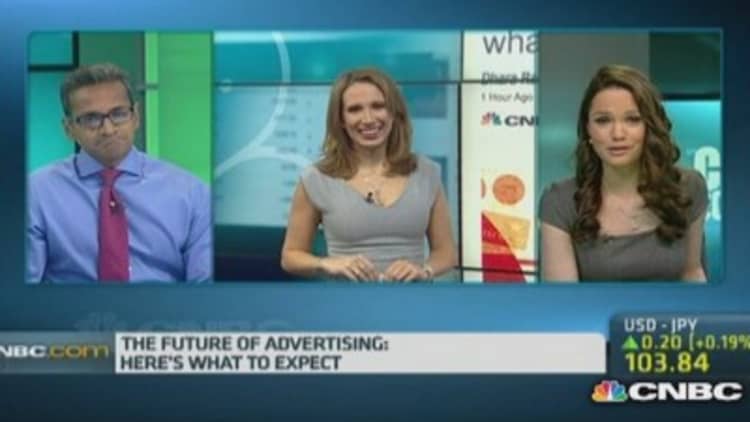Advertising is expensive. Small companies face the challenge of getting their brand known without breaking the bank, which can require a lot of time and energy, and doesn't necessarily lead to success. But resourceful firms can avoid this process, thanks to the Internet— and mainlyYoutube—where serendipity can turn a low-budget video clip into a viral sensation.
One of the viral video successes of the year was "First Kiss," which featured 10 strangers locking lips. What many of its 78 million YouTube viewers didn't realize was that "First Kiss" was an advertisement for Wren, a Los Angeles-based boutique clothier.
"We set out to make something shareable," said Melissa Coker, founder and CEO of Wren. "Emotion was our premise."
"First Kiss," which had a budget of just over $1,000, was the No. 1- branded video on YouTube in March. It attracted more traffic than videos from many big brands that have hefty advertising budgets and well-trained creative teams at their disposal.
If Wren had received a penny for each viewer, that video would have netted $780,000. "First Kiss" may have been a little too discreet, though. Coker said feedback indicated that some people had no idea that they were watching an ad. That might have been because the company abandoned niche publications in an effort to appeal to a broader audience. "We're usually used to speaking to a very fashion-savvy consumer in a very defined space," Coker said.
Read MoreNew tech gadgets to turbocharge your business
But enough viewers knew—or ultimately learned—that the strangers meeting for the fist time were models appearing in a fashion advertisement and made a connection with the brand, because Wren's sales rose by 14,000 percent after the video went viral, Coker said.
There has to be a sense of traditional advertising or branding in it so people will walk away knowing what they just watched.Neil MammeleDrinkcaffeine account manager
Chris Pirrone, the general manager of digital content for USA Today Sports, said that big companies are very deliberately trying to generate viral content, which sometimes seems like a matter of luck for smaller businesses. USA Today creates native ads—editorial content that is paid for by an advertiser but appears alongside original publisher content—with big brands.
"We're trying to build an audience of influencers and highly social people," Pirrone said.
Luck vs. pluck
Sometimes, the big brands seem to get lucky. Martha "Marty" Cobb, a peppy, comedic flight attendant for Southwest Airlines dominated social media recently when a video of her giving safety instructions went viral. Posted to a YouTube account named "Marty SWA flight attendant" which features only that sole video, it generated more than 6 million views in a week.
Though Southwest has not publicly claimed ownership of the video, an SWA spokesman said, "From a brand perspective, Marty is very much in line with our brand."
This type of viral marketing doesn't typically occur without some heavy lifting and detailed planning on the front end. There are entire teams dedicated to these successful, yet seemingly innocuous advertisements. Sharethrough, a San Francisco-based content marketing firm, specializes in the integration of ads into mobile and desktop news feeds. Sharethrough guides content to its ultimate destination, for both large and small firms.
Read More10 essentials for a sweet home office life
Sharethrough CEO Dan Greenberg said that that this type of advertising isn't for every company, but it is not just a matter of company size or budget. "If you don't have content, it's hard to do," Greenberg said.
Content can be anything from editorial write-ups to a YouTube clip, as long as it is unique to the brand, he said. One of Sharethough's smaller clients, the Robert Mondavi Private Selection, a California vineyard, produced a video with a former contestant from a Food Network competition show, Justin Warner.
"Central Coastin," features Warner rapping about drinking Mondavi wine and the central coast of California," was accompanied by the self-promoted hashtag #CentralCoastin and pushed through food and beverage websites instead of major publishers.

Neil Mammele, an account manager at drinkcaffeine, a social media-centric ad agency, said that working with smaller companies on social advertising, "forces you to be creative."
Residents of Savannah, Ga. witnessed some small business creativity in February, when Jamie Casino, a local personal injury lawyer, wrote and directed his own two-minute ad "based on a true story." It aired at the first local commercial break of the Super Bowl.
Read MoreTechnology is not a job killer: Op-ed
The ad was a dramatic—some might say creepy—rendition of Casino seeking to avenge his brother's death with the iron fist of the law. The ad went viral on Youtube—some people argued it was the best Super Bowl commercial. Casino—who has a history of low budget, local ads attracting outsize attention—declined to comment.
Brand name
Mammele said the trick to ensure attention-grabbing ads hit their mark is consistency with what the brand represents.
American Greetings, an Ohio-based greeting card company, recently made a bid for the viral video record book posting a compilation of fake interviews for "the world's toughest job" with no vacation time and no pay—being a mom. The video seemed like a misfire when it went up, but as Mother's Day approaches, success resulted—the Youtube video clip racked up 17 million views.
The company logo doesn't appear until the very end of the four-minute "toughest job" video.
Mammele said the "toughest job" video ran the risk of violating a few basic rules of native advertising and video-making with viral ambitions—rolling out under false pretenses with an obvious bid to go viral, and not indicating association with a brand right from the outset. It seemed "canned," he said.
Patrice Sadd, an American Greetings spokeswoman, said that the video was meant to mislead viewers initially. "It was intentional," she said, adding that traffic on the company website had increased since the campaign. "I believe it was an effective ad," Sadd said.
Mammele, echoing Coker's concerns, said that even doing all you can to make a video go viral doesn't guarantee that the brand will resonate with the viewer. "There has to be a sense of traditional advertising or branding in it so people will walk away knowing what they just watched," he said.
Lessons learned:
Just because you don't have a big budget doesn't mean you can't generate compelling ad content: Content truly is king and can come from anyone.
Creativity without brand relevance won't increase business: You can get the YouTube hits, but does it lead to increased sales and referrals?
Attracting attention is the goal, but leaving viewers with the feeling that they've been misled into watching an advertisement is a slippery slope.




